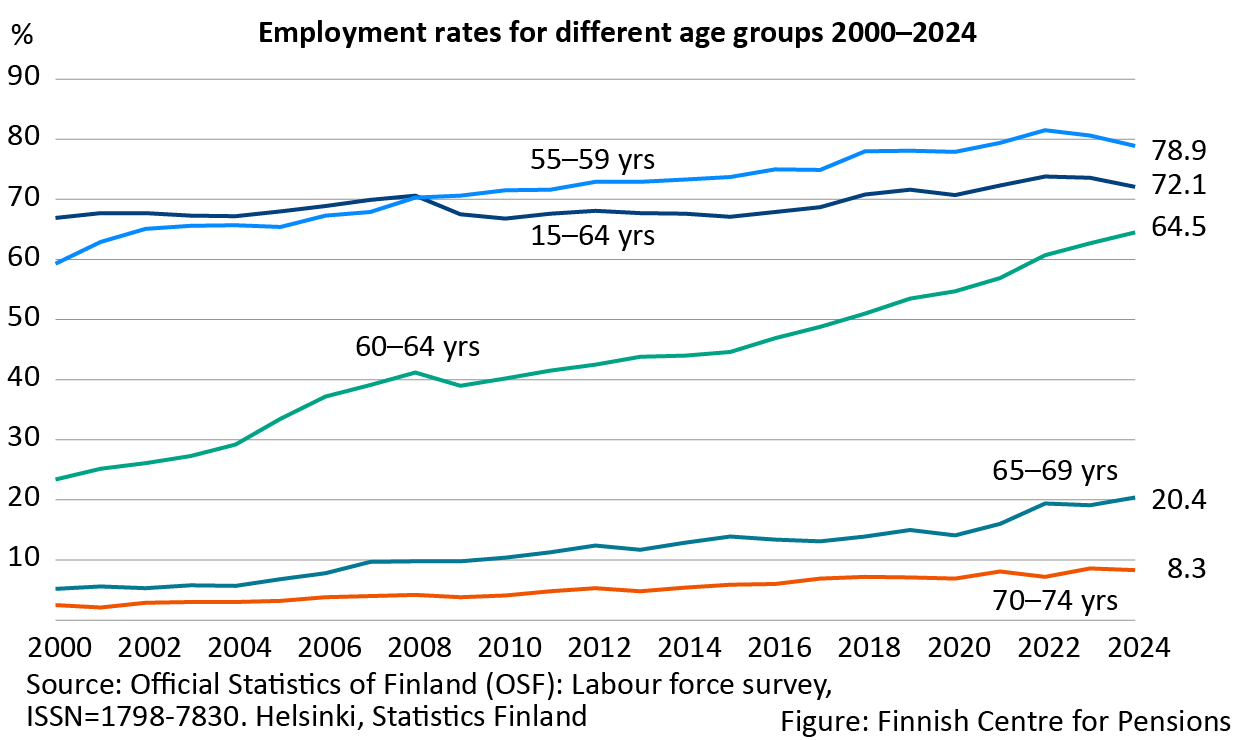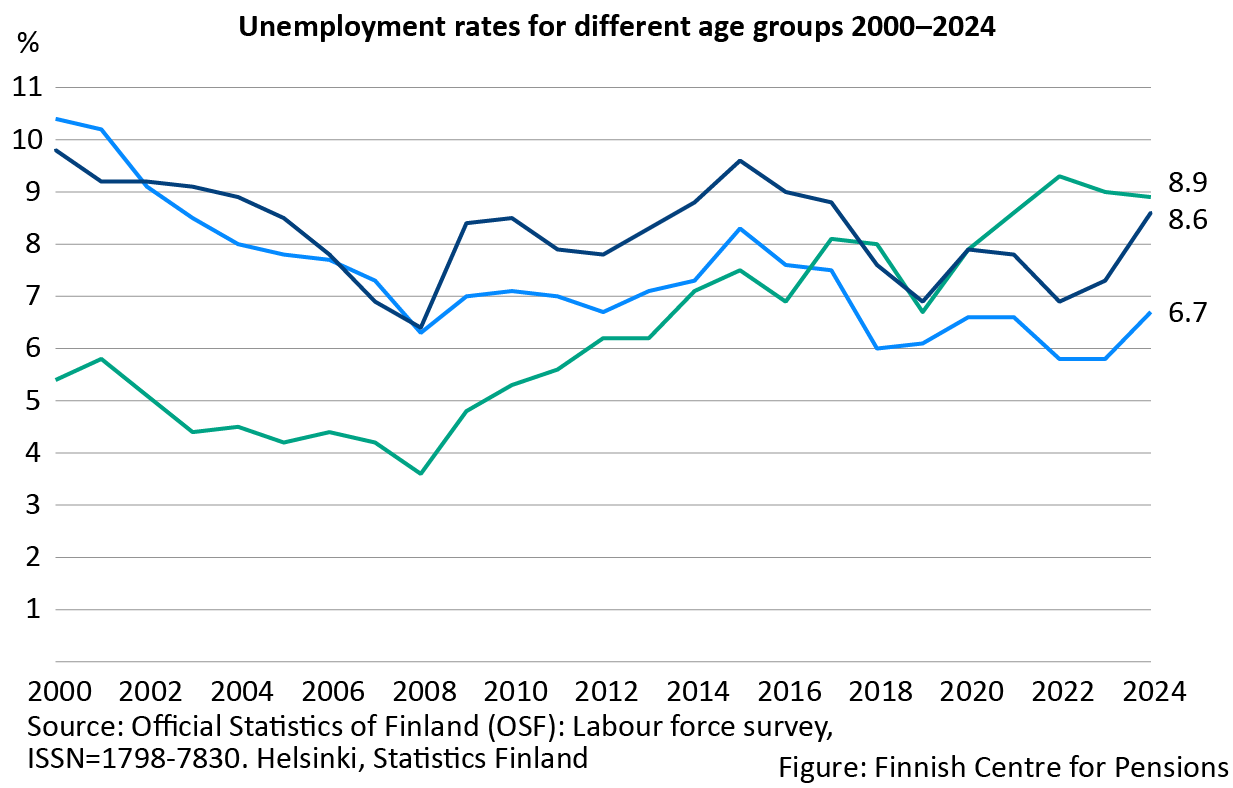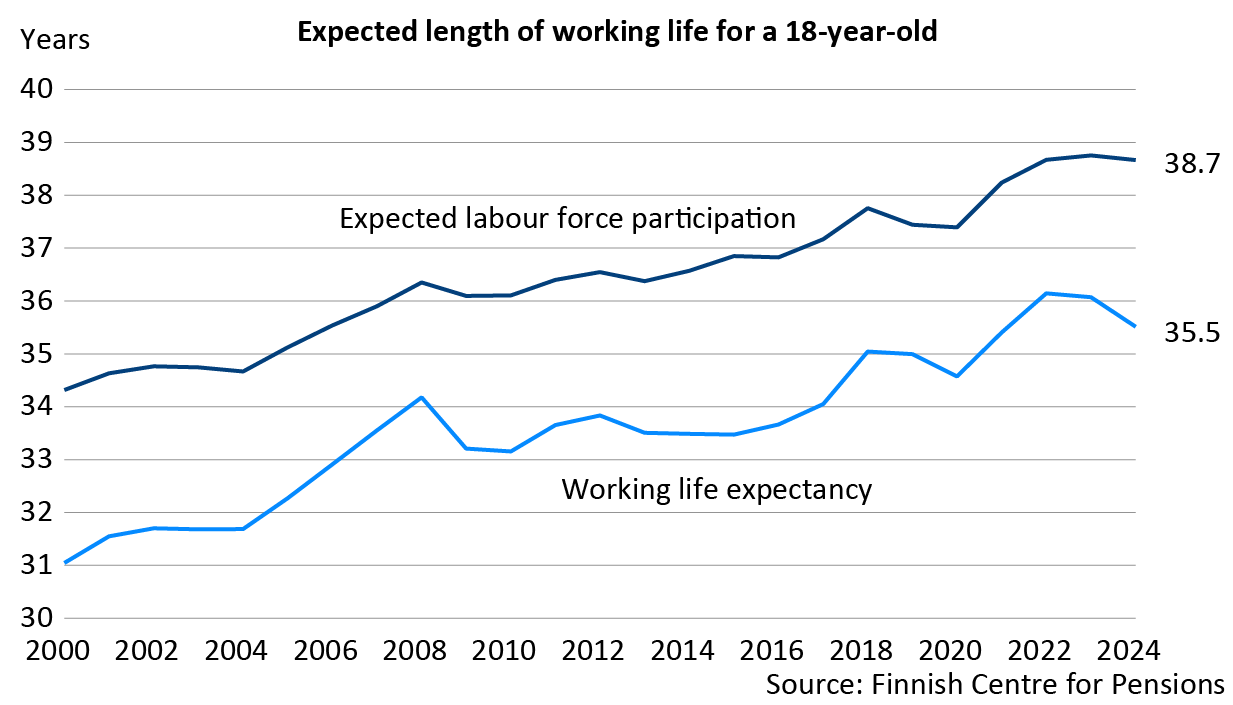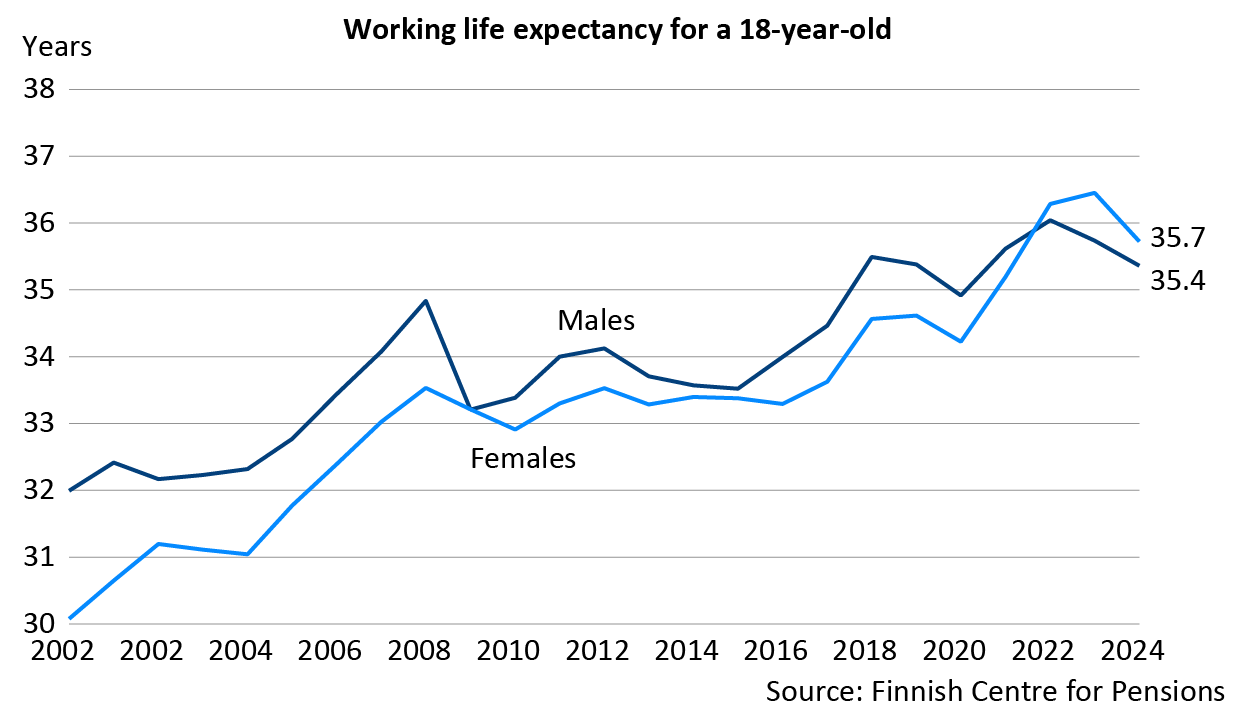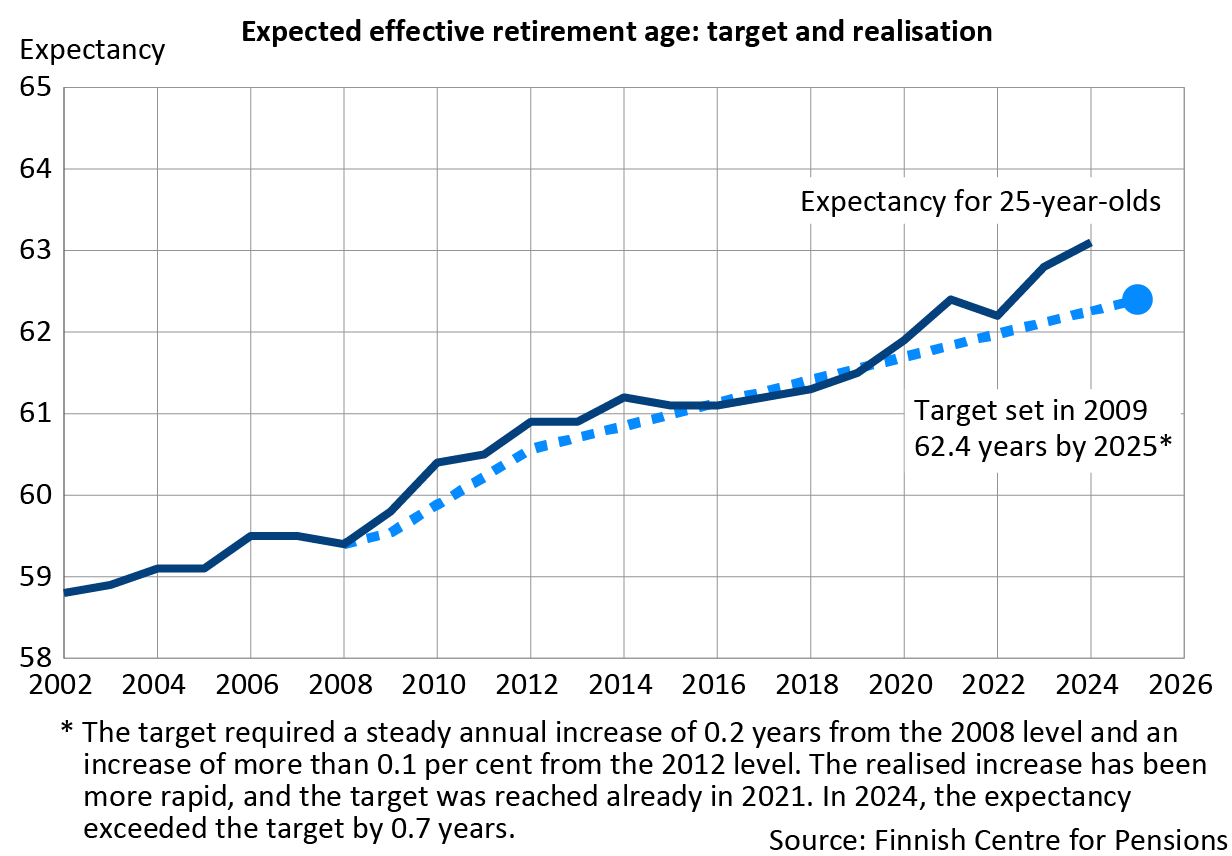Effective Retirement Age
Retirement age more than six months above target
Table: expected effective retirement age, average and median (Excel)
In 2024, the expected effective retirement age in the earnings-related pension scheme was 63.1 years, already 0.7 years above the minimum target for inscreasing the retirement age (62.4 years by 2025). This is an increase of 0.3 years compared with the previous year. The increase in the expected effective retirement age was as expected. The main reason for this change was the change in the retirement age for the old-age pension. In 2024, those born between 1 October 1959 and 30 June 1960 reached the retirement age for the old-age pension. The expectation for those aged 50 increased by 0.2 years (64.6 years).
The lowest possible target that was decided on in 2009 was already reached in 2021, when the expected effective retirement age went up to 62.4 years. This is the same as the target. The following year, however, the expectation fell due to an exceptionally high number of insured persons retiring. Between 2023 and 2024 there have been fewer old-age pensioners, which has increased the retirement age.
The number of new retirees on a disability pension fell from 2023 by 1 per cent. Between 2021 and 2024, the annual number of people retiring on a disability pension has been the lowest in the 2000s. Fewer than 18,000 disability pensions have started each year. This is surprising because, unlike in the past, pensions are now also granted to people aged 63.
In 2024, a total of 57,800 persons retired on an earnings-related pension. Around 40,000 of them retired on an old-age pension. Compared to 2023, the number of new retirees rose by 500 insured persons.
In 2024, the expected effective retirement age was 63.4 years for men and 62.7 years for women. The difference in retirement ages between men and women has been small, but since the mid-2010s, the gap has widened to more than six months. In 2024, the expected effective retirement age for men was 0.7 years higher than for women.
Particularly at the start of their working lives, women are more likely than men to retire on a disability pension, which lowers their average expected effective retirement age more than that of men. In other respects, the effective expected retirement rates for men and women are similar. In the public sector, which is dominated by women, the expected effective retirement age is slightly lower than in the private sector.
Expected effective retirement age for 25-year-olds and 50-year-olds
Employment of older people (55–64 years) shows strong growth
Employment growth slowed in 2024 but continued for the over-60-year-olds
- The employment rate for the working age population was 72.1 per cent (1.5 percentage points lower than the previous year).
- The employment performance of older workers has been good in the 2000s.
- The employment rate for the 55–59 age group fell by 1.7 percentage points from the previous year. This is down 2.6 percentage points from the historical peak of 2022.
- The employment rate for those aged 60–64 years has increased by around 2 percentage points every year since 2009. In 2024, it was 64.5 per cent. The increase was 1.8 percentage points from the previous year.
- The employment rate of 63-year-olds has risen by more than 25 percentage points since 2017. Last year, it exceeded 60 per cent for the first time.
- The employment rate of 64-year-olds has risen by more than 20 percentage points since 2020. In 2024, it was 46.6 per cent.
Unemployment rate varies by age group
- The unemployment rate for people aged 55–59 follows, but is significantly lower than, the unemployment rate for the working age population as a whole.
- The unemployment rate for people aged 60–64 has risen clearly after the financial crisis in 2008.
Length of working life in 2024
Expected labour force participation 38.7 years
- down by 0.1 years from the previous year
- up by 4.3 years over the 2000s
- for men, up by 3.8 years over the 2000s
- for women, up by 5.0 years in the 2000s
Working life expectancy for 18-year-olds 35.5 years
- down by 0.4 years from the previous year
- up by 4.5 years over the 2000s
- for men, 35.4 years (up by 3.7 years in the 2000s)
- for women, 35.8 years (up by 5.6 years in the 2000s).
(Updated on 10 February 2025)
Statistical tables:
Read more on Etk.fi:
Statistical services provides further information:
Effective Retirement Age
Producer: Finnish Centre for Pensions
Website: Effective Retirement Age
Subject area: Social security
Part of the Official Statistics of Finland (OSF): No
Description
These statistics describe the effective retirement age under the Finnish earnings-related pension scheme.
Data content
Effective retirement age is described by three measures of central tendency: expected effective retirement age, median age and average age.
Categorizations
Sector of employment, gender, age, pension benefit
Methods of data collection and source
The statistics are based on register data from the earnings-related pension scheme.
Update frequency
Once a year.
Time of completion or release
The statistics are released in the February of the year following the statistical year. The exact date of publication is given in the release calendar, go to www.etk.fi/en/statistics-2/statistics/release-calendar/.
Time series
The time series for the statistics start from 1996. Private sector time series extend back to 1983.
Key words
social insurance, pension, earnings-related pension, retirement, effective retirement age
Contact information
Expected effective retirement age
Expected effective retirement age is an indicator developed by the Finnish Centre for Pensions for the measurement of effective retirement age. The indicator is unaffected by the population age structure. It describes the average effective retirement age for persons of a certain age who are insured under the earnings-related pension scheme, proceeding from the assumption that the retirement and mortality rates for each age group are unchanged from the year of observation.
Expected effective retirement age is calculated for both 25-year-olds and 50-year-olds. The expectancy for 25-year-olds describes the effective retirement age for the whole population with earnings-related pension insurance, and it is used as the official indicator to describe changes in effective retirement age.
The expectancy for 50-year-olds is calculated for insured persons who have reached the age of 50. As persons who have retired before age 50 are not included in the calculation, the expectancy for 50-year-olds is always higher than for 25-year-olds. The difference describes the impact that people retiring at age 25–49 have on effective retirement age.
Average
Average retirement age is the arithmetic mean of the ages of new retirees. Average age is calculated based on age at the onset of retirement.
Median
Median retirement age is the midpoint observation for the dataset, i.e. half of the new retirees are younger and the other half older than the median. Median age is calculated based on age at the onset of retirement.
New retirees on earnings-related pension
New retirees on an earnings-related pension are defined as persons whose pension based on their own employment started during the statistical year, or whose pension eligibility has started earlier but who have only received a decision on their pension during the statistical year. A further requirement is that the person has not received any employment-based pension in one’s own right (excluding part-time pension and partial early old-age pension) for at least two years.
Figures for different types of pension benefit require that the person has not received the pension benefit in question for two years. For new retirees on an old-age pension, the person shall not have received any employment-based pension in one’s own right (excluding part-time pension and partial old-age pension) for two years.
Statistics for partial early old-age pension, which was introduced in 2017, are compiled using the same rules as for part-time pension. In other words, persons who have chosen to take early payment of a partial old-age pension are not counted as new retirees.
Survivors’ pensions are excluded from the examination of new retirees.
Sector-specific examinations are always focused on the sector concerned, i.e. the number of new retirees is determined based on pensions within that sector alone. In the case of the entire earnings-related pension system, it is required that the person has not received a pension from either sector for two years.
Insured persons
In this set of statistics persons insured for an earnings-related pension are defined as persons covered by the pension system who do not receive an employment-based pension (excluding part-time pension and partial old-age pension). The population insured for an earnings-related pension in the year under review is calculated based on the corresponding number at the end of the previous year.
The earnings-related pension scheme consists of the private and the public sector. Around three in four persons insured under this scheme are employed in the private sector and one in three in the public sector. Over the course of the year less than ten per cent work in both sectors.
Private sector pension acts:
- Employees’ Pensions Act
- Seafarers’ Pensions Act
- Self-Employed Persons’ Pensions Act
Farmers’ Pensions Act - Act on Farmers’ Early Retirement Aid
Public sector pension acts:
- Public Sector Pensions Act
- Pension acts concerning Bank of Finland employees,
- the regional government of the Åland Islands, and
- Members of Parliament and the Council of State.
The introduction of the Public Sector Pensions Act on 1 January 2017 combined and replaced the Local Government Pensions Act, the State Employees’ Pensions Act, the Evangelical-Lutheran Church Pensions Act and a separate act concerning employees of the Social Insurance Institution of Finland.
Quality description: Effective Retirement Age 2024
The statistics on effective retirement age are compiled and published by the Finnish Centre for Pensions.
The Act on the Finnish Centre for Pensions states that one of the agency’s roles is to compile statistics relating to its functions. Responsibility for the production of statistics at the Finnish Centre for Pensions rests with the Planning Department.
The costs of producing these statistics are borne by the Finnish Centre for Pensions.
Relevance of statistical information
These statistics describe the effective retirement age under the Finnish earnings-related pension scheme.
The phenomenon is described using three measures of central tendency: expected effective retirement age, median age and average age. The indicators used describe effective retirement age in different ways and are suited to different purposes.
Expected effective retirement age
Expected effective retirement age is an indicator developed by the Finnish Centre for Pensions for the measurement of effective retirement age. It describes the average effective retirement age for persons of a certain age who are insured under the earnings-related pension scheme, proceeding from the assumption that the retirement and mortality rates for each age group are unchanged from the year of observation. The indicator only reacts to changes in retirement rates: it is unaffected by changes in the population structure and other demographic phenomena.
Expected effective retirement age is calculated for both 25-year-olds and 50-year-olds. The expectancy for 25-year-olds describes the effective retirement age for the whole population with earnings-related pension insurance, and it is used as the official indicator to describe changes in effective retirement age.
Of the three indicators used, expected effective retirement age provides the most accurate measure of changes over time in effective retirement age.
Average
Average retirement age is the arithmetic mean of the ages of new retirees. Average age is calculated based on age at the onset of retirement.
Average is the most commonly used indicator in international comparisons of effective retirement age.
Median
Median retirement age is the midpoint observation for the dataset, i.e. half of the new retirees are younger and the other half older than the median. Median age is calculated based on age at the onset of retirement.
Median is well-suited to describing the typical effective retirement age in a highly skewed distribution.
New retirees on an earnings-related pension
A new retiree on an earnings-related pension is defined as a person whose pension based on his or her own employment started during the statistical year, or whose pension eligibility has started earlier but who has only received a pension decision during the statistical year.
Persons retiring on a part-time pension or taking early payment of a partial old-age pension are not counted as new retirees.
The concepts and definitions used in the statistics are presented on the statistics homepage at www.etk.fi/statistics/effective-retirement-age/concepts-and-definitions
Correctness and accuracy of data
The statistics are based on register data from the earnings-related pension scheme.
The Finnish Centre for Pensions has responsibility for the content of the central registers of the earnings-related pension scheme, as well as for the management and development of related operations. Provisions on the Finnish Centre for Pensions’ register-keeping duties are set out in the Act on the Finnish Centre for Pensions.
The numbers of new retirees, persons insured for an earnings-related pension and deceased persons in different age groups are derived from register data from the register sources. The analyses are based on total datasets.
Errors found in the statistics are immediately corrected online. A separate bulletin is issued in case of significant errors.
Timeliness and promptness of published data
The statistics are released once a year in the February of the year following the statistical year. The exact date of publication is given in the Finnish Centre for Pensions release calendar.
Coherence and comparability of data
The statistics have been compiled since 2003 and time series have been produced retrospectively back to 1996. Private sector time series extend to 1983.
The figures presented in the statistics are consistent with those in the statistics on Earnings-related pension recipients in Finland and Persons insured for an earnings-related pension in Finland.
Changes in earnings-related pension legislation must be taken into account when interpreting the statistics.
Read more:
Availability and clarity of data
The statistical data are released annually on the statistics homepage and in the Finnish Centre for Pensions statistical database at https://tilastot.etk.fi.
The statistics are described on the statistics homepage at www.etk.fi/statistics/effective-retirement-age/description.
For further information on these statistics, contact the Finnish Centre for Pensions Statistical Services at tilastot(at)etk.fi.
Definition and method of calculating expected effective retirement age
The expected effective retirement age describes the average effective age of retirement for insured persons of a certain age, assuming that the retirement risk and mortality for each age group remain unchanged at the level of the year of observation.
The expected effective retirement age is obtained by first calculating the mortality and retirement rates for each age group in the year of observation. These rates can then be used to calculate the number of people who in a group of insured persons of a selected size and age (say 100,000 insured persons aged 25 years) would retire within one year.
The number of persons insured at age 26 is then obtained by deducting from the original number those who have retired and the number of deceased persons based on mortality rates. This is repeated one year at a time through to retirement age until the notional number of new retirees is obtained for all age groups. The average age of these notional new retirees is the expected effective retirement age.
Expected effective retirement age is calculated as follows:
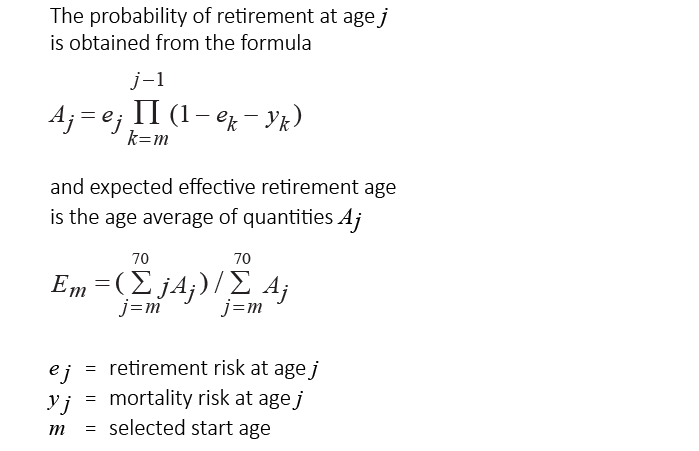
Until the end of 2004 the general retirement age in Finland was 65 years. For 2004 and earlier, therefore, the termination age used in the formula was 65 years. With the introduction in 2005 of flexible old-age retirement between ages 63 and 68, the upper limit in the formula was increased to 70 years. It is estimated that this hike in the termination age from 65 to 70 years increased the expected effective retirement age by just over 0.1 years.
Requirements set for expected effective retirement age
- The indicator reacts correctly to changes in the number of starting pensions. It falls if the number of starting pensions rises in any of the age groups below retirement age, and rises if the number of starting pensions falls.
- The indicator only reacts to changes in the number of starting pensions. It is unaffected by demographic phenomena such as the population age structure.
- The indicator reacts immediately to changes in the number of starting pensions since the calculations are based on starting pensions. If the calculations were based on the number of retired persons, the changes would be slow to show up in the results.
- The statistical data needed to calculate the indicator are available. The Finnish Centre for Pensions maintains a central register of all earnings-related pensions and persons insured for an earnings-related pension, which allows for calculations based on the number of starting pensions.
The indicator of expected effective retirement age satisfies these four basic requirements.
It might be tempting to add to this list the requirement of international comparability, but it may be difficult to obtain comparable data other than for the Nordic countries.
Calculations of expected effective retirement age for a very small population will also have limited value because the number of starting pensions should describe the probability of retirement for each age cohort of the population. It follows that calculations of expected effective retirement age for the personnel of an individual company, for example, are not meaningful.
Aim to defer effective retirement age
Since the 1990s, efforts have been made to contain the upward pressure on pension contributions. Extending working lives and raising the retirement age have emerged as key measures. Changes in working life are mainly monitored by the employment rate of older people and the retirement age by the expected effective retirement age developed by the Finnish Centre for Pensions.
- The 2005 pension reform set the long-term goal of delaying retirement by 2–3 years. The exact time frame for achieving this goal was not specified.
- In the spring of 2009, the government and the social partners negotiated a more precise increase target: the expected retirement age should rise to at least 62.4 years by 2025. At a steady pace, the expected effective retirement age should have increased by almost 0.2 years per year.
- The 2011 government programme reaffirmed the target for increasing the expected effective retirement age.
- The 2013 structural policy programme also confirmed the target of increasing the expected effective retirement age to at least 62.4 years by 2025. Achieving this target at that time required an annual increase of just over 0.1 years.
- In the explanatory memorandum to the 2017 pension reform, the target for the expected effective retirement age was still set at 62.4 years.
- In 2021, the target was reached, but in 2022 the expected retirement age fell by 0.2 years. In 2024, the minimum target was exceeded by six months, with an increase to 63.1 years.
